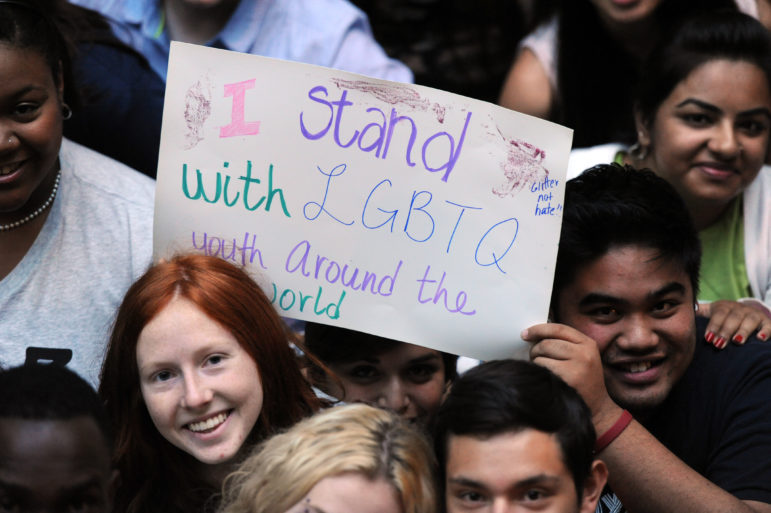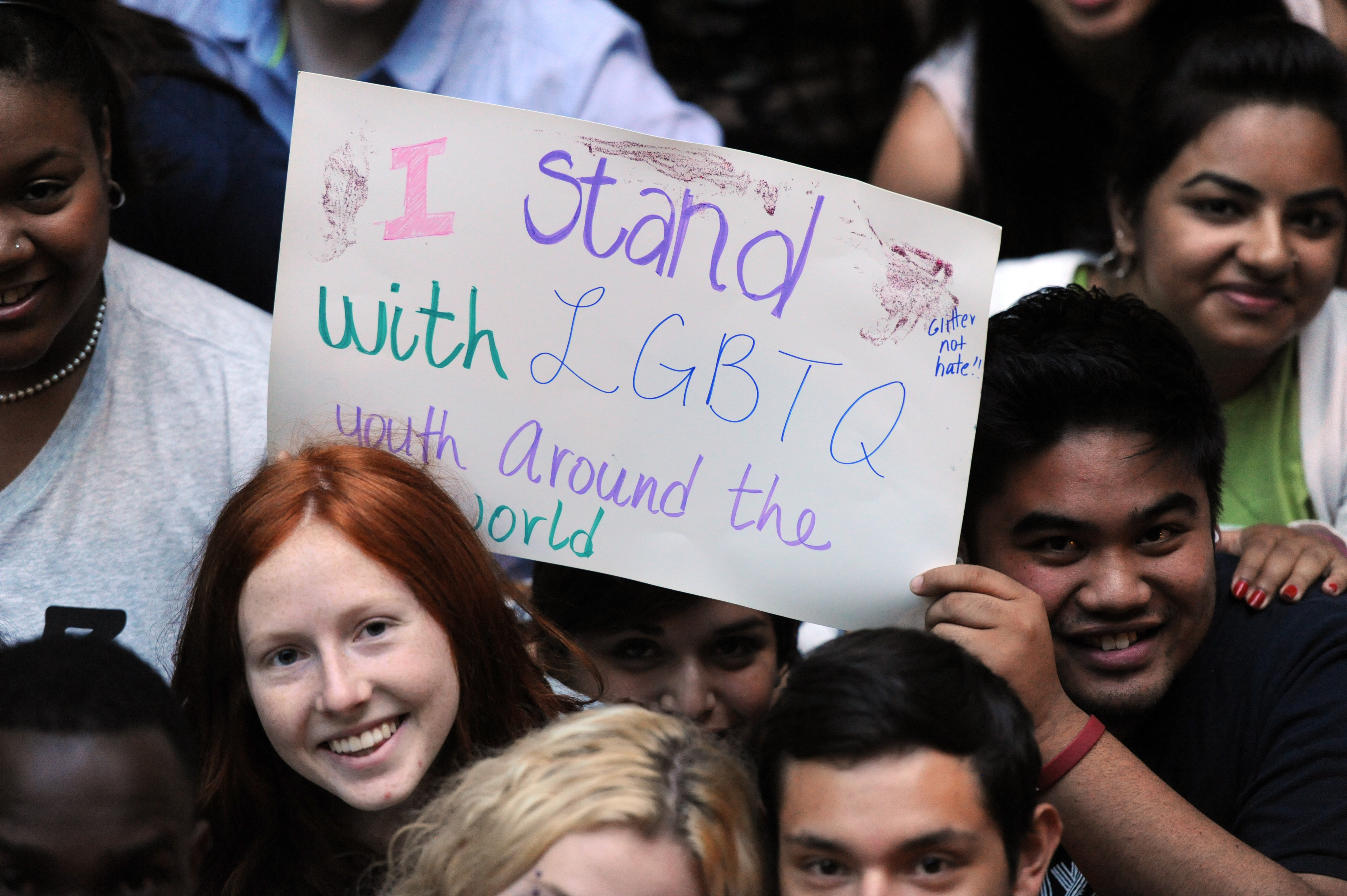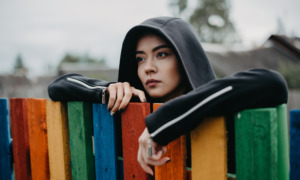
Advocates for Youth
Advocates for Youth is among organizations working to help LGBTQ young people thrive. A CDC report earlier in August showed high levels of violence against sexual minority youth.
About 8 percent of high school students are lesbian, gay or bisexual, according to the first nationwide survey asking teens about their sexuality.
The survey results released by the Centers for Disease Control and Prevention earlier this month found that these teenagers face a shockingly high level of violence compared with their straight peers.
The report is a call to action for adults who care about youth, said Debra Hauser, president of Advocates for Youth, a nonprofit focusing on the health of young people.
A great deal of progress has been made in LGBT rights, “and yet we see such incredibly alarming disparities,” she said.
According to the survey, LGB teens were three times as likely as straight students to have been raped. They were twice as likely to have been threatened or injured at school. And nearly 30 percent had made a suicide attempt in the year before the survey.
Many LGBT youth feel hopeless and sad, Hauser said. It is devastating to see the level of bullying and violence against them, she said.
One in 10 LGB students said they had missed school in the previous month because of safety concerns. Twenty-three percent had experienced dating violence, compared with 9 percent of straight youth. Sixty percent said they were so sad or hopeless they had stopped doing their usual activities.
The survey, known as the Youth Risk Behavior Survey, measures more than 100 behaviors that affect health and well-being. The latest survey, given in 2015, asked questions of more than 15,000 young people in ninth through 12th grade, and for the first time asked how they identified themselves sexually and also the sex of those with whom they had sexual contact. The survey did not ask whether students defined themselves as transgender. The CDC’s analysis also included data from 25 state surveys and 19 large urban school district surveys to produce the report “Sexual Identity, Sex of Sexual Contacts, and Health-Related Behaviors Among Students in Grades 9-12 — United States and Selected Sites, 2015.”
Emily Greytak, director of research for GLSEN, a nonprofit that supports the needs of LGBT students in schools, called the report “disheartening but not surprising.”
“What we may be seeing is a lot of backlash right now” in response to the Supreme Court decision on marriage equality and the passage of nondiscrimination laws, Greytak said.
There’s been a possible uptick in anti-LGBT statements on social media, she said.
[Related: Discrimination Lands Many LGBT Youth in the Justice System, New Report Says]
Improving the world for LGBT youth
The CDC report called for action to create safe and supportive environments for sexual minority youth.
Greytak listed four keys to improvement.
- Supportive adults: One supportive adult can make a major difference in the life of a LGBT kid, Greytak said. Collectively, supportive adults can change the whole climate surrounding a young person, she said. Teachers and adults in youth development programs need training. They need to know not only how to intervene to stop bullying and harassment, but also how to be proactive.
- Inclusive curricula: For example, if an out-of-school program provides career exploration for students, why not include a lesbian as a role model, Greytak asked.
- Student organizations: Gay-straight alliances should be supported in schools and communities, Greytak said. They can educate others and advocate for gay students. Other youth organizations can make a difference by taking part in events such as the GLSEN-sponsored Day of Silence or joining a pride march.
- Policy changes: Schools and organizations should adopt anti-bullying policies that specifically protect kids based on sexual orientation and gender identity or expression, in addition to race, color, sex, national origin, disability and religion. This type of policy statement gives teachers and staff permission to address the issues — and makes them accountable if they do not.
“Calling it out is really important,” Greytak said. Some teachers otherwise feel they don’t have permission.
Organizations should also look at policies that marginalize LGBT youth, she said. For example, forms that list a child’s mother and father could be changed to list “Parent 1” and “Parent 2.”
‘Safe spaces for adults to take responsibility’
Hauser, of Advocates for Youth, said young people need to have good connections to family and to school. They need to believe in themselves and see themselves reflected in the community around them.
“We need to create safe spaces for adults to take responsibility,” she said. Brave administrators are needed to protect employees so they can come out and be role models, she said.
LGBT youth “want to see themselves reflected in the educators who are teaching them,” she said. This helps youth advocate for themselves.
In youth organizations, kids need a welcoming space. That may mean having LGBT staff members as well as those reflecting the ethnicity of the youth.
“We need to hold up historical figures who have made a difference in areas such as math, science and the arts,” she said, so young people know there’s a pathway for them.
Every young person needs information about healthy relationships, Hauser said.
If young people don’t see themselves reflected in discussions about relationships and sex education, at best they will ignore the discussions.
If sex education doesn’t reflect the experience of LGBT students, why would they listen? Hauser asked.
Often the experience for LGBT youth in sex education is that they’re erased, she said. “It’s devastating,” she said.
Hauser said that the No. 1 question kids ask sex education instructors is: “Am I normal?”
“All young people have questions around puberty,” she said. “If they’re not getting answers, it creates terrible anxiety.”
Schools are afraid of controversy if they tackle these subjects, Hauser said. “We need some brave folks to step up to the plate.”
“Our LGBT youth are resilient,” she said. “We need to really connect with and affirm our young people. Given the right supports they will thrive.”
More related articles:
CDC Finds LGB Students at Greater Risk of Bullying, Sexual Violence
Youth in Sex Trade Not All Young Girls With Pimps, Study Shows
Building Trust and Support for Homeless Youth in OST Programs
































